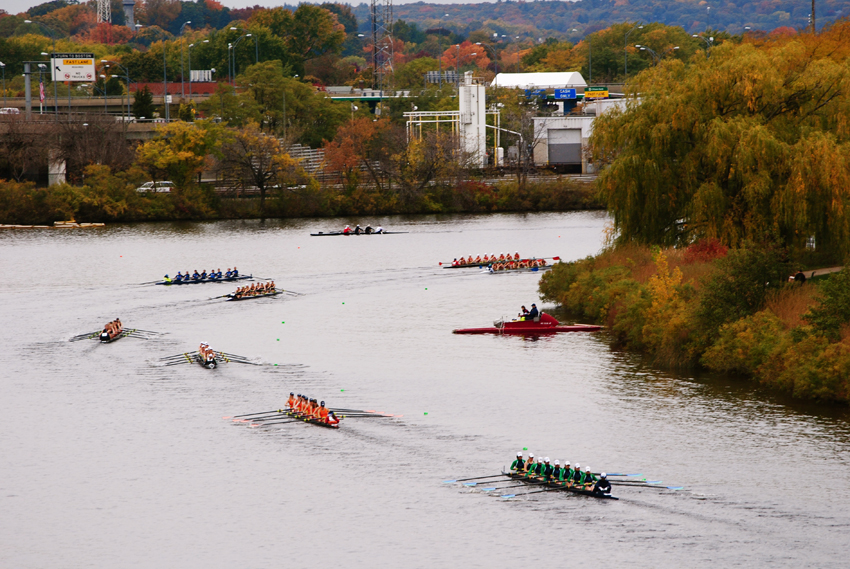Viewers’ Guide: Head of the Charles Regatta in Boston

Race Time by Casey Eisenreich on Flickr
Select Activities for the 2013 Head of the Charles
• Eliot Bridge Enclosure: Come and go as you please all weekend for food by West Bridge and premium beverages in this hospitality tent. $90 for one day, $150 for Saturday and Sunday, south end of Eliot Bridge. • Weld Exhibition: Located at Harvard’s Weld Boathouse between the Weeks and Lars Anderson Bridges, you’ll find plenty of sponsors with merchandise, snacks, and refreshments at this prime HOCR viewing spot. Saturday and Sunday, Weld Boathouse. • Rowing & Fitness Expo: Find everything rowing-related at the Rowing and Fitness expo, where 70-plus vendors set up to entice you with all sorts of retail goodies. Open Friday (at noon) through Sunday, Christian Herter Park in Allston, between Eliot Bridge and the finish. • Live Webcast: We get it, some people just weren’t made for the outdoors. No matter. HOCR.org will host a live webcast of this weekend’s event.
Bridge Guide to the HOCR
One of the major issues with outdoor events like the Head of the Charles Regatta (HOCR), which takes place this weekend, is finding the best place to sit or stand. Crowding along the Charles River can be tricky, and though you may feel as though your only option is to climb a tree or occupy a random rooftop, early birds can snatch a spot on one of many bridges, which prove to be great vantage points. Here is a breakdown. The BU Bridge (Mile 1): Here’s where the race starts. The boats line up in the order of their boat numbers (with the beautiful Boston skyline in the distance), and while you may only get to see them quickly take off, it’s an exciting moment as the crews begin in their “high strokes.” Bring it on, Charles! River Street and Western Avenue Bridges (Mile 2): As racers begin their second mile, they enter a long straightaway that they consider the “Powerhouse Stretch,” potentially giving them a chance to catch up or pass. River Street Bridge and the Western Avenue Bridge are great spots to witness this tense moment in the competition. Weeks Footbridge (Mile 2): This bridge provides spectators with a bit of edge-of-your-seat entertainment. Located right near a sharp 90 degree turn in the river course, it makes for the perfect place to witness collisions or, at the very least, rowers’ frustration at attempting to avoid a seemingly inevitable crash. Anderson Memorial Bridge (Halfway): Right around the halfway mark are Harvard’s Weld and Newell boathouses. Once you’ve witnessed the boats pass, you might consider heading down to Harvard Square via JFK Street (which connects to Anderson Bridge) for some shopping, good eats, and rest. There, you can congratulate finished competitors at the bars on Saturday evening. Eliot Bridge (Mile 3): Located near the Cambridge Boat Club (the regatta’s headquarters), the Eliot Bridge offers a view of another intense turn in the course. If you are seeking the chance to get a little closer, trek down to the dock outside Belmont Hill/Windsor’s boathouse. Once the boaters are out of sight (and nearing the end), you might want to check out the Rowing and Fitness Expo, complete with vendors and food stands. The Finish Area Launch Site (FALS) provides athletes and viewers with an abundance of delicious food—not to mention a chance to meet London Olympians (more than 100 of them from 15 different countries will be racing at the regatta). U.S. Olympic rowers will also be around for an autograph signing. Finish Line at Christian Herter Park: Rest up, you’ve made it. Walking alongside the course will not be as tiresome as the rowers’ experience, but the entirety of the HOCR can exhaust anybody. Take the time to praise the competitors, stuff your face, and down some beer at a local pub.
HOCR Facts & Figures
You probably already know that the HOCR attracts thousands of spectators to the Charles each year, from proud parents to school-spirited students to curious passersby. But to expand your knowledge base before the big event, we’ve gathered a bit of extra information that you may choose to bring up during mid-HOCR sideline chat. • The HOCR began in 1965 and attracts more than 9,000 athletes and 300,000 viewers each year. It is the world’s largest two-day rowing event. • A “head” race is a type of regatta that is normally three miles long. The first HOCR was proposed by Englishman Ernest Arlett, a sculling instructor at Harvard who wanted there to be a race in Boston similar to those held back in his country. • Five of the 15 HOCR Board of Directors oversee the race committee, a team of 12 that meets year-round to organize the event, and which seeks the help of 80 volunteers on 30 different committees. Frederick V. Schoch, who coached rowing at Princeton, Georgetown, and the U.S. Naval Academy, was made Executive Director of the Regatta in 1991. • The first rowing race in the U.S. was between Harvard and Yale in 1852. • A sweep is a rower who rows with one oar, who is generally part of a 2-person, 4-person, or 8-person boat. A sculler rows with two oars, and they usually row without a coxswain in singles, doubles, or quads. • The coxswain is the oarless crew member responsible for steering and yelling out commands. • An eight shell (boat), which can hold more than 1,750 pounds, typically weighs about 200 pounds itself. • The bow is the back of the shell, and rowers move it “backward.” The bow is the first part of the boat to cross the finish line. • Boats compete against one another as well as the clock. They start about 15 seconds apart, sequentially. • Rowers travel from high schools, colleges, and clubs all over the country and from other nations as well. Championship events typically include members of the U.S. National Team. • The race is 3.2 miles long—spanning from BU’s DeWolfe Boathouse to the Eliot Bridge before NEU’s Henderson Boathouse. • The boathouses offer open houses during the event. If you have some extra time to kill, take advantage! • The Weld Expedition on the Cambridge side of the river offers live music, vendors, and food stalls for the public to enjoy. • The only place where alcohol is served legally at the HOCR is in the tents of Reunion Village, where alumni associations come together during the event.
HOCR By the Numbers
300,000+ – spectators who will line the banks 10,234.88 – distance traveled in miles by athletes from Sydney, Australia, to race at the regatta 40,000 – average cost in U.S. dollars of an 8+ boat 9,000 – rowers who will try their luck on the course 1965 – year of the first Head of the Charles 190-200 – weight, in pounds, of an 8+ (sans rowers) 130 – maximum weight, in pounds, of lightweight women’s rowers 54.2 – average length, in feet, of an 8+ 41.9 – average length, in feet, of a 4+ 31 – average weight, in pounds, of a 1x (one rower, 2 sculling oars) 26.9 – average length, in feet, of a 1x 12.4 – average length, in feet, of a sweep oar (used by 8+s and 4+s) 9.7 – average length, in feet, of a sculling oar (used by 4x, 2x and 1x) 9 – athletes in an 8+, the plus-one being the coxswain who steers the course 8 – blades in an eight (8+) and a quad (4x). The eight is a sweep shell and rowers hold one oar, the quad (like the double 2x and single 1x) skull with 2 oars. 7 – boathouses passed on the course: BU, Riverside, Harvard-Radcliffe’s Weld, Harvard’s Newell, Cambridge Boat Club, BBN, and Belmont Hill/Windsor (Northeastern’s boathouse is just beyond the finish line) 6 – bridges to navigate on the regatta course. From the start: BU, River Street, Western Avenue, Weeks, Anderson, and Eliot 5 – kinds of shells raced at the regatta, the 8+, the 4+, the 4x, the 2x, and the 1x And finally… 3 miles of racing for 1 title, the Head of the Charles. The Head of the Charles Regatta is this Saturday and Sunday, October 19-20 along the Charles River. Races take place from 8 a.m. to 5 p.m. For more info about the HOCR, including race times, map, and shuttle schedule, visit hocr.org. Facts and figures information via Head of the Charles Regatta and Hopper.com. Bridge Guide and HOCR By the Numbers provided by hopper.com/blog.


